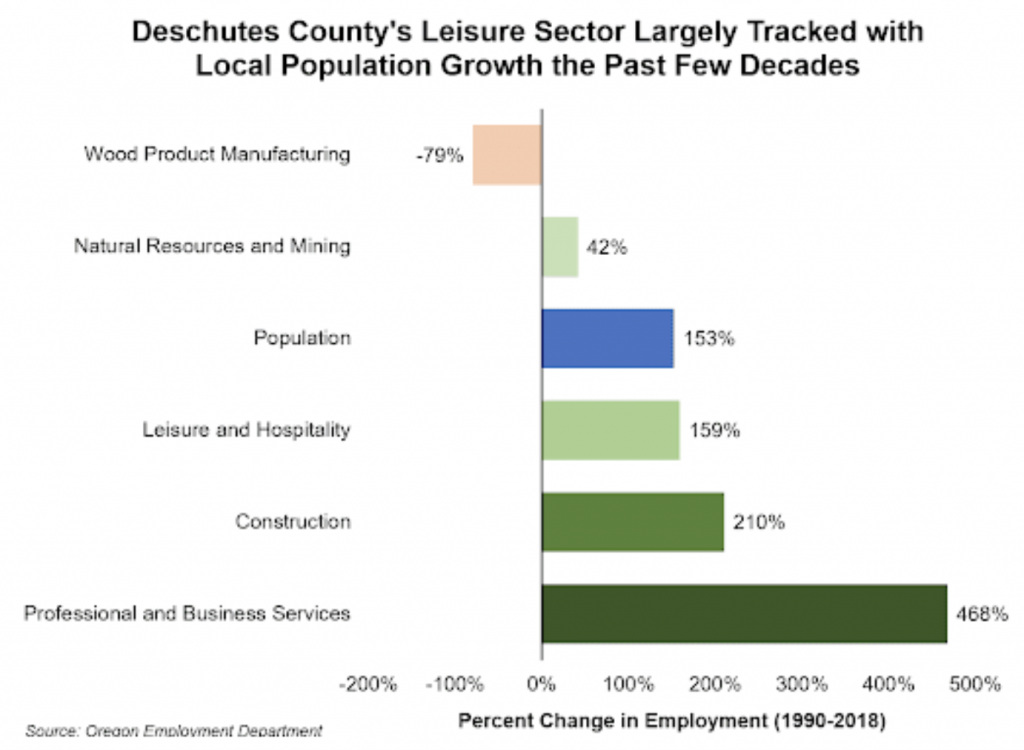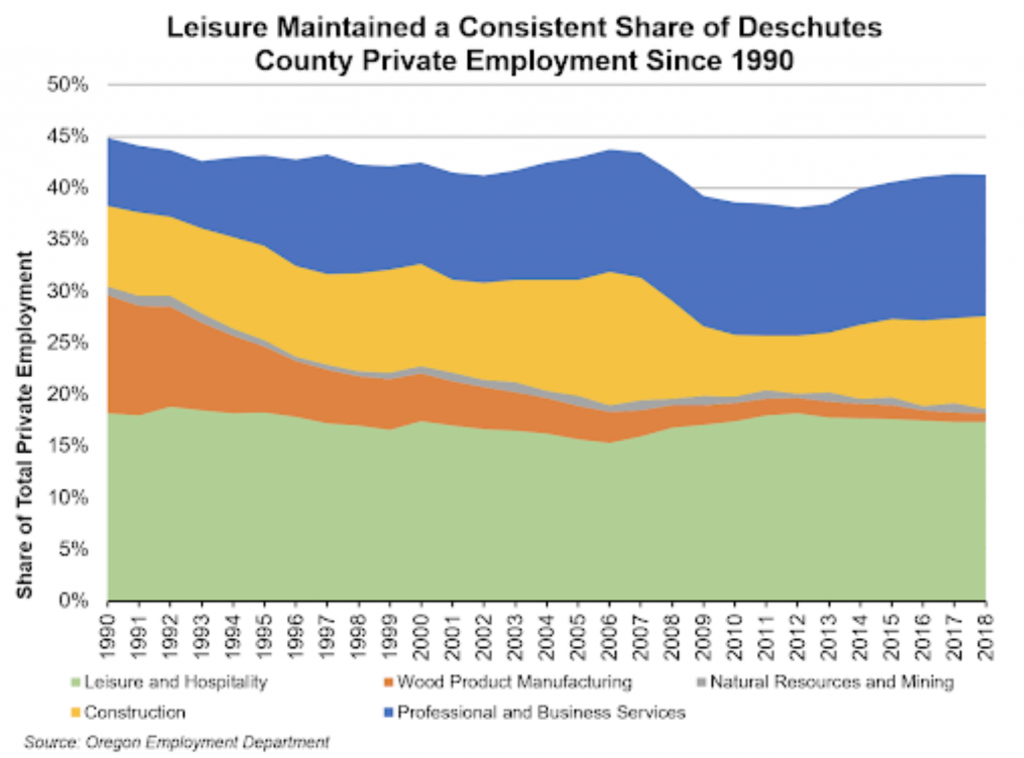The Myth of Bend’s Timber-to-Tourism Transition

by Damon Runberg
You may have heard this story before. Bend was a timber town, but after the demise of the timber industry, the regional economy shifted to tourism to replace those timber jobs. The vast ponderosa forests outside of town attracted mills that sustained the town for much of its history. The present location of the Old Mill District shopping center was once the home of two large competing mills, Brooks-Scanlon Lumber Company and Shevlin-Hixon Lumber Company. Later, the Shevlin-Hixon mill was acquired by Brooks-Scanlon. By 1994, the last mill down at the “Old Mill” site closed. This site was eventually redeveloped into the shopping center that most of us are familiar with today. It is a retail and entertainment hub that attracts both tourists and locals alike. The story of the Old Mill site is representative of this broader story about Bend and Central Oregon’s economy shifting to a tourism-based economy after the decline of the timber industry.
Employment declines in the wood products sector began before the 1990s due to fewer large diameter trees, new technology, international competition, and industry consolidation. Increased regulation on federal forest lands began in the early 1990s and dealt a major blow to the once dominant industry. In 1994, the Northwest Forest Plan became enacted by the Clinton Administration, which sought to take into account the needs of endangered species when harvesting on public lands across the Pacific Northwest.

It is true that natural resources and wood products have been declining over the past several decades, both in total employment and as a share of total private employment. Back in 1990, prior to the impact of new federal regulations on public forests, wood products and natural resources accounted for 12.3 percent of total private employment in Deschutes County. That share dropped to 1.3 percent as of 2018. A major shift. However, is it true that tourism replaced wood products? It doesn’t seem that way.
Leisure and hospitality, a good proxy for tourism-related jobs, has maintained a relatively stable share of Deschutes County’s total private employment going back to 1990. In fact, the leisure sector accounted for a larger share of total private employment back in 1990 than in 2018. The share of our private-sector economy in leisure and hospitality has not fluctuated much. It reached a low of about 15 percent in 2006 and a high of about 18 percent in 1992.

What was becoming a larger share of our economy as timber and wood products was declining? Construction. Beginning in the mid-1990s through the mid-2000s construction experienced rapid growth, leading to a peak of nearly 13 percent of the county’s total private employment by 2006. This construction growth was the result of population gains, but it is also a housing bubble. We know how that ended.
Interestingly, the industry that has really begun to gain a notable share of total private employment in this economic cycle is professional and business services. The broad professional sector only accounted for 6.5 percent of all private sector jobs in 1990 and 9.9 percent by 2000. However, that share rose to nearly 14 percent by 2018, rapidly approaching leisure and hospitality’s share of 17 percent.
The common narrative that tourism replaced or supplanted the timber and wood products sector is wrong. Going back to 1990, leisure and hospitality has maintained a relatively constant share of the region’s private-sector jobs. In reality, there have been several structural transitions to Bend’s economy over the past 30 years. Construction largely supplanted wood products in the late 1990s and early 2000s. In this current expansion, professional and business services has experienced significant growth, becoming one of the areas dominant industries.


okay, so take this a step further….WHY is the business and professional services area along with construction booming so well for so long? What is so attractive in Bend that could be duplicated in other cities?
Good topic to bring up, about duplicating Bend’s success or demise to some folks. As a pretty much life long resident of the west I’ve seen the Bend example occur numerous times throughout the west, just a few examples; Glenwood Springs, Durango, Aspen, CO. Whitefish, Kalispell, Missoula, MT. Northern Idaho is full of examples along with Boise. Bend is not an exception, but just an example of where outdoor types want to live. I’ve seen wealth attract wealth like Sun Valley, ID, or Big Sky, MT. Youth and 20 30 something folks love these places as I did in the 80’s and 90’s. The big difference today is the lack of housing and the cost of living. Today. as my daughter has found out trying to make ends meet in Bend on a 65k yearly income, finds herself renting a room instead of an apartment. She is now on a waiting list for a 1 bedroom apartment that has yet to be built. Until we realize that housing and health care costs are holding down folks from getting a head, we will be in this dilemma. We have to understand that we have to make a transition to apartments, duplexes, multiple family housing development rather than single family dwellings. Health care needs to be dealt with and costs need to be more competitive. Those two issues would make the middle class in America much more middle class rather than lower class.